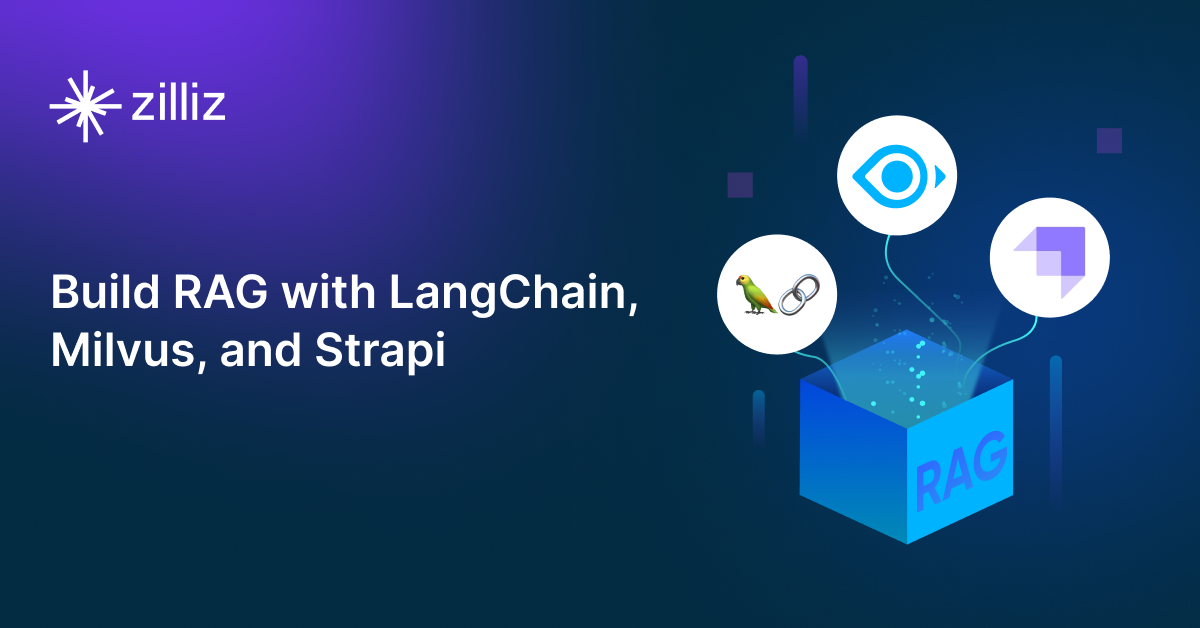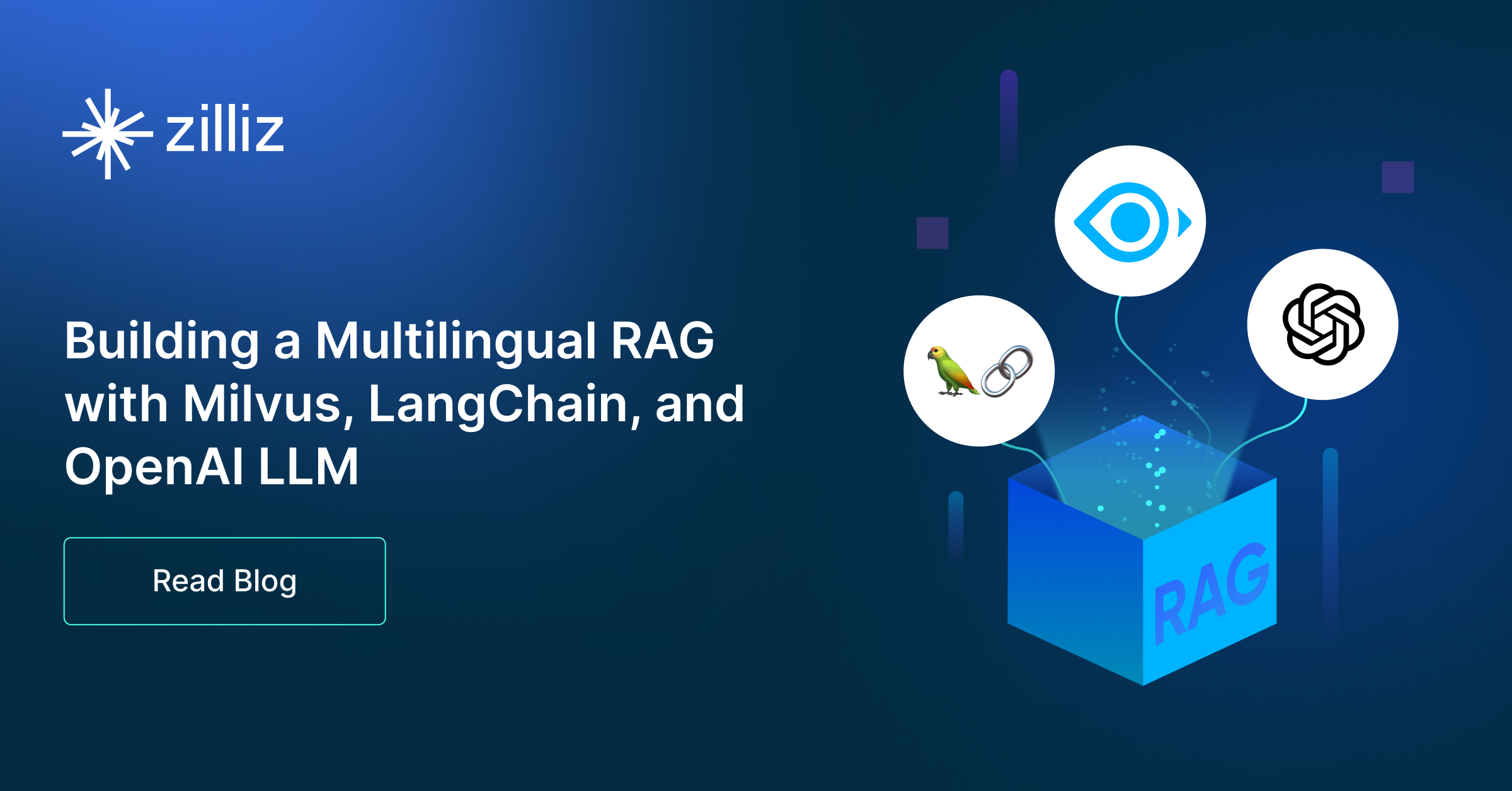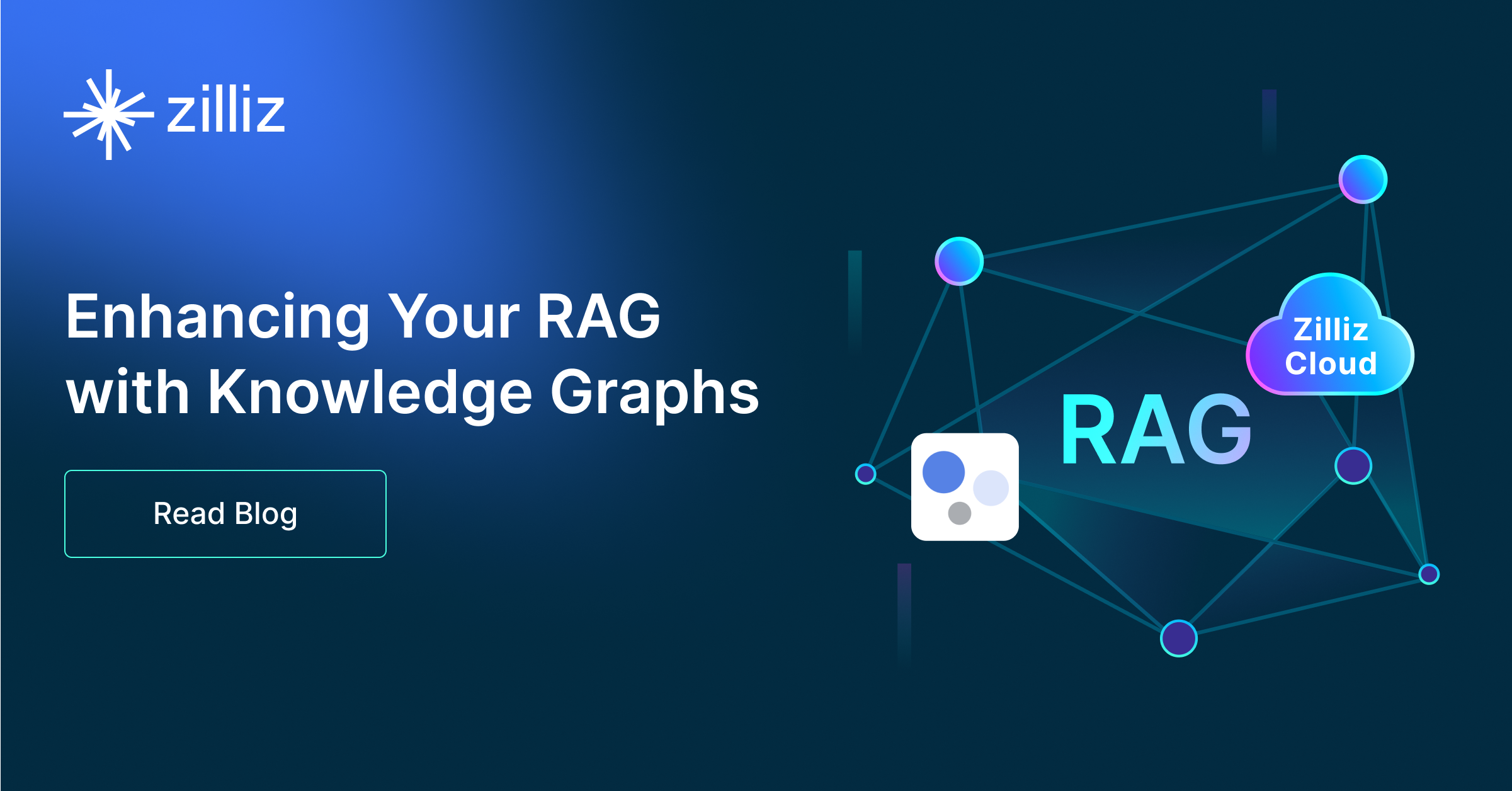Build RAG Chatbot with LangChain, OpenSearch, Groq llama3-70b-8192, and mistral-embed
Introduction to RAG
Retrieval-Augmented Generation (RAG) is a game-changer for GenAI applications, especially in conversational AI. It combines the power of pre-trained large language models (LLMs) like OpenAI’s GPT with external knowledge sources stored in vector databases such as Milvus and Zilliz Cloud, allowing for more accurate, contextually relevant, and up-to-date response generation. A RAG pipeline usually consists of four basic components: a vector database, an embedding model, an LLM, and a framework.
Key Components We'll Use for This RAG Chatbot
This tutorial shows you how to build a simple RAG chatbot in Python using the following components:
- LangChain: An open-source framework that helps you orchestrate the interaction between LLMs, vector stores, embedding models, etc, making it easier to integrate a RAG pipeline.
- OpenSearch: An open-source search and analytics suite derived from Elasticsearch. It offers robust full-text search and real-time analytics, with vector search available as an add-on for similarity-based queries, extending its capabilities to handle high-dimensional data. Since it is just a vector search add-on rather than a purpose-built vector database, it lacks scalability and availability and many other advanced features required by enterprise-level applications. Therefore, if you prefer a much more scalable solution or hate to manage your own infrastructure, we recommend using Zilliz Cloud, which is a fully managed vector database service built on the open-source Milvus and offers a free tier supporting up to 1 million vectors.)
- Groq llama3-70b-8192: The llama3-70b-8192 model is a large language model developed by Meta, featuring 70 billion parameters and an 8,192-token context window. This model is designed for general-purpose language tasks, including text generation, summarization, and translation. Groq, a company specializing in AI hardware and software solutions, offers the llama3-70b-8192 model through its API. This integration allows developers to leverage Groq's high-performance Language Processing Unit (LPU) for efficient inference. Groq's LPU is known for its deterministic, single-core streaming architecture, which provides predictable and repeatable performance for AI workloads.
- Mistral-Embed: Mistral-Embed is a cutting-edge embedding model designed for high-dimensional text representation. It excels in tasks such as semantic search, similarity measurement, and recommendation systems, providing accurate contextual embeddings. Ideal for enhancing NLP applications, it balances performance with scalability, making it suitable for both research and real-world implementations.
By the end of this tutorial, you’ll have a functional chatbot capable of answering questions based on a custom knowledge base.
Note: Since we may use proprietary models in our tutorials, make sure you have the required API key beforehand.
Step 1: Install and Set Up LangChain
%pip install --quiet --upgrade langchain-text-splitters langchain-community langgraph
Step 2: Install and Set Up Groq llama3-70b-8192
pip install -qU "langchain[groq]"
import getpass
import os
if not os.environ.get("GROQ_API_KEY"):
os.environ["GROQ_API_KEY"] = getpass.getpass("Enter API key for Groq: ")
from langchain.chat_models import init_chat_model
llm = init_chat_model("llama3-8b-8192", model_provider="groq")
Step 3: Install and Set Up mistral-embed
pip install -qU langchain-mistralai
import getpass
import os
if not os.environ.get("MISTRALAI_API_KEY"):
os.environ["MISTRALAI_API_KEY"] = getpass.getpass("Enter API key for MistralAI: ")
from langchain_mistralai import MistralAIEmbeddings
embeddings = MistralAIEmbeddings(model="mistral-embed")
Step 4: Install and Set Up OpenSearch
pip install --upgrade --quiet opensearch-py langchain-community
from langchain_community.vectorstores import OpenSearchVectorSearch
opensearch_vector_search = OpenSearchVectorSearch(
"http://localhost:9200",
"embeddings",
embedding_function
)
Step 5: Build a RAG Chatbot
Now that you’ve set up all components, let’s start to build a simple chatbot. We’ll use the Milvus introduction doc as a private knowledge base. You can replace it with your own dataset to customize your RAG chatbot.
import bs4
from langchain import hub
from langchain_community.document_loaders import WebBaseLoader
from langchain_core.documents import Document
from langchain_text_splitters import RecursiveCharacterTextSplitter
from langgraph.graph import START, StateGraph
from typing_extensions import List, TypedDict
# Load and chunk contents of the blog
loader = WebBaseLoader(
web_paths=("https://milvus.io/docs/overview.md",),
bs_kwargs=dict(
parse_only=bs4.SoupStrainer(
class_=("doc-style doc-post-content")
)
),
)
docs = loader.load()
text_splitter = RecursiveCharacterTextSplitter(chunk_size=1000, chunk_overlap=200)
all_splits = text_splitter.split_documents(docs)
# Index chunks
_ = vector_store.add_documents(documents=all_splits)
# Define prompt for question-answering
prompt = hub.pull("rlm/rag-prompt")
# Define state for application
class State(TypedDict):
question: str
context: List[Document]
answer: str
# Define application steps
def retrieve(state: State):
retrieved_docs = vector_store.similarity_search(state["question"])
return {"context": retrieved_docs}
def generate(state: State):
docs_content = "\n\n".join(doc.page_content for doc in state["context"])
messages = prompt.invoke({"question": state["question"], "context": docs_content})
response = llm.invoke(messages)
return {"answer": response.content}
# Compile application and test
graph_builder = StateGraph(State).add_sequence([retrieve, generate])
graph_builder.add_edge(START, "retrieve")
graph = graph_builder.compile()
Test the Chatbot
Yeah! You've built your own chatbot. Let's ask the chatbot a question.
response = graph.invoke({"question": "What data types does Milvus support?"})
print(response["answer"])
Example Output
Milvus supports various data types including sparse vectors, binary vectors, JSON, and arrays. Additionally, it handles common numerical and character types, making it versatile for different data modeling needs. This allows users to manage unstructured or multi-modal data efficiently.
Optimization Tips
As you build your RAG system, optimization is key to ensuring peak performance and efficiency. While setting up the components is an essential first step, fine-tuning each one will help you create a solution that works even better and scales seamlessly. In this section, we’ll share some practical tips for optimizing all these components, giving you the edge to build smarter, faster, and more responsive RAG applications.
LangChain optimization tips
To optimize LangChain, focus on minimizing redundant operations in your workflow by structuring your chains and agents efficiently. Use caching to avoid repeated computations, speeding up your system, and experiment with modular design to ensure that components like models or databases can be easily swapped out. This will provide both flexibility and efficiency, allowing you to quickly scale your system without unnecessary delays or complications.
OpenSearch optimization tips
To optimize OpenSearch in a Retrieval-Augmented Generation (RAG) setup, fine-tune indexing by enabling efficient mappings and reducing unnecessary stored fields. Use HNSW for vector search to speed up similarity queries while balancing recall and latency with appropriate ef_search and ef_construction values. Leverage shard and replica settings to distribute load effectively, and enable caching for frequent queries. Optimize text-based retrieval with BM25 tuning and custom analyzers for better relevance. Regularly monitor cluster health, index size, and query performance using OpenSearch Dashboards and adjust configurations accordingly.
Groq llama3-70b-8192 optimization tips
To optimize Groq llama3-70b-8192 in a Retrieval-Augmented Generation (RAG) system, focus on efficient batch processing to maximize throughput by grouping multiple requests together. Utilize mixed precision for faster computation while maintaining model accuracy, and adjust input sequence length to strike a balance between context richness and computational efficiency. Leverage model parallelism to distribute workloads across multiple processing units, ensuring scalability. Regularly monitor GPU utilization and ensure that memory is efficiently managed by freeing unused tensors to prevent bottlenecks. Fine-tune the model on specific tasks or domains to improve accuracy and reduce inference time. Additionally, consider pruning or quantizing certain layers to optimize performance for production-level tasks without compromising too much on model output quality.
mistral-embed optimization tips
mistral-embed is a versatile embedding model suitable for diverse text-based RAG applications. To enhance retrieval, optimize embedding quality by fine-tuning on domain-specific data to capture nuanced semantic relationships. Use efficient vector search techniques like FAISS or HNSW to quickly identify relevant documents from large datasets. For better storage management, compress embeddings without sacrificing accuracy, such as through quantization or dimensionality reduction. To maximize throughput, batch embedding requests and use multi-threading to parallelize computations. Regularly update the embedding store with new data to ensure freshness and accuracy in retrieval. Optimize model performance by tuning hyperparameters such as temperature and top-k to balance precision and diversity in retrieved results.
By implementing these tips across your components, you'll be able to enhance the performance and functionality of your RAG system, ensuring it’s optimized for both speed and accuracy. Keep testing, iterating, and refining your setup to stay ahead in the ever-evolving world of AI development.
RAG Cost Calculator: A Free Tool to Calculate Your Cost in Seconds
Estimating the cost of a Retrieval-Augmented Generation (RAG) pipeline involves analyzing expenses across vector storage, compute resources, and API usage. Key cost drivers include vector database queries, embedding generation, and LLM inference.
RAG Cost Calculator is a free tool that quickly estimates the cost of building a RAG pipeline, including chunking, embedding, vector storage/search, and LLM generation. It also helps you identify cost-saving opportunities and achieve up to 10x cost reduction on vector databases with the serverless option.
 Calculate your RAG cost
Calculate your RAG cost
What Have You Learned?
By diving into this tutorial, you’ve unlocked the power of combining cutting-edge tools to build a functional RAG system from the ground up! You learned how LangChain acts as the glue that binds everything together, orchestrating workflows between your vector database, LLM, and embedding model. OpenSearch stepped in as your robust vector database, handling the heavy lifting of storing and retrieving semantic embeddings generated by Mistral-Embed—a model that transforms text into rich numerical representations. Then, Groq’s lightning-fast Llama3-70B-8192 took center stage, using those retrieved contexts to generate insightful, accurate responses that feel almost human. Along the way, you saw how tweaking chunk sizes, adjusting metadata filters, or experimenting with hybrid search strategies can optimize performance, turning a basic RAG setup into a finely tuned knowledge engine. And let’s not forget the bonus: that handy RAG cost calculator you explored ensures you can scale your projects without breaking the bank!
Now, you’re equipped to build smarter, faster, and more efficient AI applications. Imagine what’s next—customizing retrieval logic, fine-tuning embeddings for niche domains, or even integrating multimodal data! The tools are in your hands, and the possibilities are endless. So go ahead, experiment fearlessly, iterate boldly, and let your creativity shape the future of intelligent systems. You’ve got the blueprint; it’s time to bring your ideas to life. Happy building! 🚀
Further Resources
🌟 In addition to this RAG tutorial, unleash your full potential with these incredible resources to level up your RAG skills.
- How to Build a Multimodal RAG | Documentation
- How to Enhance the Performance of Your RAG Pipeline
- Graph RAG with Milvus | Documentation
- How to Evaluate RAG Applications - Zilliz Learn
- Generative AI Resource Hub | Zilliz
We'd Love to Hear What You Think!
We’d love to hear your thoughts! 🌟 Leave your questions or comments below or join our vibrant Milvus Discord community to share your experiences, ask questions, or connect with thousands of AI enthusiasts. Your journey matters to us!
If you like this tutorial, show your support by giving our Milvus GitHub repo a star ⭐—it means the world to us and inspires us to keep creating! 💖
- Introduction to RAG
- Key Components We'll Use for This RAG Chatbot
- Step 1: Install and Set Up LangChain
- Step 2: Install and Set Up Groq llama3-70b-8192
- Step 3: Install and Set Up mistral-embed
- Step 4: Install and Set Up OpenSearch
- Step 5: Build a RAG Chatbot
- Optimization Tips
- RAG Cost Calculator: A Free Tool to Calculate Your Cost in Seconds
- What Have You Learned?
- Further Resources
- We'd Love to Hear What You Think!
Content
Vector Database at Scale
Zilliz Cloud is a fully-managed vector database built for scale, perfect for your RAG apps.
Try Zilliz Cloud for Free


